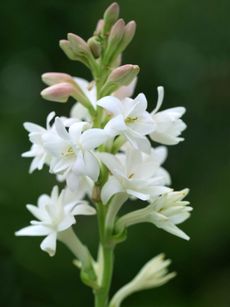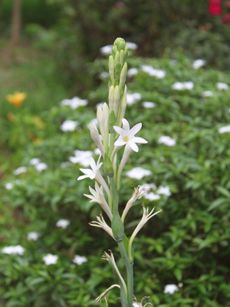Tuberose Plant Info: Learn About The Care Of Tuberose Flowers


Fragrant, showy flowers in late summer lead many to plant tuberose bulbs. Polianthes tuberosa, which is also called the Polyanthus lily, has a strong and enticing fragrance that furthers its popularity. Clusters of large white blooms form on stalks that can reach 4 feet (1 m.) in height and rise from grass-like clumps. Keep reading about the care of tuberose flowers in the garden.
Tuberose Plant Info
Polianthes tuberosa was discovered by explorers in Mexico as early as the 1500's and was one of the first flowers to be returned to Europe, where it gained popularity in Spain. The showy blooms are commonly found in the United States in the Texas and Florida gulf areas and are grown commercially in San Antonio.
Learning how to grow tuberose in the home garden is simple, however, care of tuberose flowers after bloom requires effort, proper timing, and storage of the tuberose bulbs (actually rhizomes), which must be dug up before winter in some areas. Tuberose plant info indicates the rhizomes can be damaged at conditions of 20 degrees F. (-7 C.) or below.
How to Grow Tuberose
Plant tuberose bulbs in spring when all danger of frost is past. Place the rhizomes 2 to 4 inches (5-10 cm.) deep and 6 to 8 inches (15-20 cm.) apart, in well-draining soil in a sunny spot. Note: Polyanthus lily likes hot afternoon sun. Keep the soil consistently moist before and during the period of bloom that occurs in late summer. Enrich poor soil with compost and organic amendments to increase drainage and texture for the best show of tuberose flowers. Best results of blooms come from the cultivar Mexican Single, which is highly fragrant. ‘Pearl' offers double blooms as big as 2 inches (5 cm.) across. ‘Marginata' has variegated blooms.
Care of Tuberose Flowers and Bulbs
When blooms are spent and foliage is yellowed, bulbs must be dug up and stored for winter protection in northern areas. Tuberose plant info varies as to which gardening zones can leave the bulbs in the ground over the winter. All recommend spring planting, but autumn digging and storage is said by some to be necessary in all but zones 9 and 10. Others say tuberose bulbs can be left in the ground as far north as USDA Hardiness Zone 7. Those in Zones 7 and 8 might consider planting Polianthes tuberosa in a sunny, somewhat sheltered microclimate, such as near a wall or building. Heavy winter mulch helps protect the plant from cold winter temperatures.
Storage of Tuberose Bulbs
Rhizomes of Polianthes tuberosa can be stored during the winter at temperatures of 70 to 75 degrees F. (21-24 C.), according to most tuberose plant info. They may also be air dried for seven to ten days and stored in a cool location at 50 degrees F. (10 C.) for replanting next spring. Experiment with storage options when learning to how to grow tuberose, using the option which is most convenient for you.
Gardening tips, videos, info and more delivered right to your inbox!
Sign up for the Gardening Know How newsletter today and receive a free download of our most popular eBook "How to Grow Delicious Tomatoes."

Becca Badgett was a regular contributor to Gardening Know How for ten years. Co-author of the book How to Grow an EMERGENCY Garden, Becca specializes in succulent and cactus gardening.
-
 Shrub Diseases And Pests To Watch Out For
Shrub Diseases And Pests To Watch Out ForShrub diseases and pests can be challenging. Learn how to recognize and eradicate them before they can present a danger to your plants.
By Susan Albert
-
 Foodscaping: The Most Beautiful Way To Grow Your Own Food
Foodscaping: The Most Beautiful Way To Grow Your Own FoodFoodscaping is a beautiful and profoundly practical way to mix beauty and function in your yard. Try food landscaping for a real sense of abundance.
By Bonnie L. Grant
-
 Tuberose Bulb Planting: How And When To Plant Tuberose
Tuberose Bulb Planting: How And When To Plant TuberosePlanting a tuberose bulb in the garden will add excitement with minimal care. How and when to plant tuberose is key to success. Learn more here.
By Tonya Barnett
-
 Tuberose Plant Division: How To Divide Tuberoses In The Garden
Tuberose Plant Division: How To Divide Tuberoses In The GardenDividing tuberose plants takes some careful maneuvering as you separate those roots to grow new plants. Find tips on getting this done here.
By Mary Ellen Ellis
-
 Indoor Tuberose Care: Can You Grow Tuberose As A Houseplant
Indoor Tuberose Care: Can You Grow Tuberose As A HouseplantWith basic needs provided, there’s no reason you can’t enjoy potted tuberoses inside. Click here to learn how to grow tuberose as a houseplant.
By Mary H. Dyer